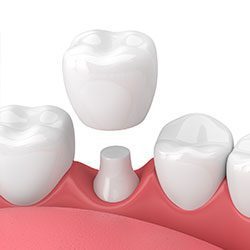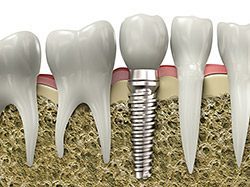Restorative Dentistry in Seattle, WA

During your first dental examination with x-rays, you will be given the opportunity to discuss your dental health and goals. What is important to you, is priority for us. You will be presented with options to meet your dental goals. We offer many different services. But, you will be invited to join the decision-making process of what dental treatment will work best for you. In partnership with YOUR dentist, you will have a healthy smile and know you were a part of the process. Leaving the dental office feeling confident and informed of your dental plan is our goal.

Crowns are a restorative procedure used to improve your tooth’s shape or to strengthen a tooth. Crowns are most often used for teeth that are broken, worn, or have portions destroyed by tooth decay.
A crown is a “cap” cemented onto an existing tooth that usually covers the portion of your tooth above the gum line. In effect, the crown becomes your tooth’s new outer surface. Crowns can be made of porcelain, metal, or both. Porcelain crowns are most often preferred because they mimic the translucency of natural teeth and are very strong.
Crowns or onlays (partial crowns) are needed when there is insufficient tooth strength remaining to hold a filling. Unlike fillings, which apply the restorative material directly into your mouth, a crown is fabricated away from your mouth. Your crown is created in a lab from your unique tooth impression, which allows a dental laboratory technician to examine all aspects of your bite and jaw movements. Your crown is then sculpted just for you so that your bite and jaw movements function normally once the crown is placed.

If you are missing teeth, it is crucial to replace them. Without all your teeth, chewing and eating can destabilize your bite and cause you discomfort. When teeth are missing, your mouth can shift and even cause your face to look older. Implants are a great way to replace your missing teeth, and if properly maintained, can last a lifetime!
An implant is a new tooth made of metal and porcelain that looks just like your natural tooth. It’s composed of two main parts: one part is the titanium implant body that takes the place of the missing root, and the second part is the tooth-colored crown that is cemented on top of the implant. With implant treatment, you can smile confidently knowing no one will ever suspect you have a replacement tooth.
In addition to tooth replacement, implants may be used to anchor dentures, especially lower dentures that tend to shift when you talk or chew. For patients with removable partial dentures, implants can replace missing teeth so you have a more natural-looking smile.

Traditional dental restoratives, or fillings, are most often made of silver amalgam. The strength and durability of this traditional dental material makes it useful for situations where restored teeth must withstand extreme forces that result from chewing, often in the back of the mouth.
Newer dental fillings include ceramic and plastic compounds that mimic the appearance of natural teeth. These compounds, often called composite resins, are usually used on the front teeth where a natural appearance is important, but they can also be used on the back teeth depending on the location and extent of the tooth decay.
There are two different kinds of fillings: direct and indirect. Direct fillings are fillings placed into a prepared cavity in a single visit. They include silver amalgam, glass ionomers, resin ionomers, and composite (resin) fillings. Indirect fillings generally require two or more visits. They include inlays, onlays, and veneers. They are used when a tooth has too much damage to support a filling but not enough to necessitate a crown.

Dentures are natural-looking replacement teeth that are removable. There are two types of dentures: full and partial. Full dentures are given to patients when all of the natural teeth have been removed. Partial dentures are attached to a metal frame that is connected to your natural teeth and are used to fill in where permanent teeth have been removed. Just like natural teeth, dentures need to be properly cared for. Use a gentle cleanser to brush your dentures, always keep them moist when they’re not in use, and be sure to keep your tongue and gums clean as well.

Many times, we hear from new patients that when they left other dental offices, they had more questions than answers. As a valued patient, every question and concern you have is important and each will be answered to your satisfaction.
Partial crowns, often referred to as onlay’s, are a type of dental restoration or porcelain filling that covers one or more cusps of your tooth. Onlay’s are also made of porcelain by a lab and take two appointments to complete. An inlay is like a dental filling, but the restoration is made of porcelain by a lab and is placed within the cusps on a tooth’s chewing surface. These restorations are much more conservative than crowns and can be imperceptible from your natural tooth. However, the use of onlays and inlays are limited to very specific situations and are not as common as a dental crown.
What is a Dental Inlay?
An inlay is a lab fabricated porcelain filling that fits into the grooves of a tooth and do not extend over the cusps of tooth. The patient is numbed using a local anesthetic and the dentist drills the tooth to remove and clean out the decay in the tooth. This is one of the restorative methods used to repair a tooth after it sustains harm from injury or decay that does not affect the cusps of the tooth. The dentist takes an impression and sends it to a laboratory where the inlay is made.
Inlays are manufactured from porcelain or composite resin material matching the color of the tooth and provide almost invisible dental restoration while repairing the chewing surface. Dental inlays are generally more durable than regular fillings made from composite or amalgam.
What is a Dental Onlay?
Onlays also fit inside the tooth but extend onto the chewing surface of a back tooth to replace one or more cusps. In the past, onlays were made only of gold, but like inlays, more and more patients request a tooth-colored onlay. Making the onlay of ceramic/porcelain allows the restoration to be bonded to the tooth.
This bonding process may actually improve the strength of the tooth and help seal the onlay to the tooth. Sometimes It is difficult to determine when inlays or onlays can be used instead of crowns or caps. But, you are in great hands at Laurelhurst Family Dentistry as our dentists will review all your options with you to determine the best dental plan.
Conservative gold preps that wear well and typically last longer in the mouth than composite or amalgam materials. Gold is much more fracture resistant than porcelain restorations.


Tucker technique gold restorations are considered the “Golden Standard of Dentistry“.
Yes, we live in fast times and a very media generated world, but one thing has not changed and that no dental restoration has yet surpassed the high standard set by gold.
Aesthetics are very important today; however, not everything should be driven aesthetically, and not every patient desires aesthetics over function. The Academy of Richard V. Tucker Study Clubs is dedicated to providing education for those dentists seeking the highest level of training and expertise in restoring teeth with the most conservative, long-lasting cast gold restorations. The conservative approach leads to very aesthetic restorations that show little if any gold while still being durable and exceptionally well-sealed.
Please visit www.arvtsc.org for more information about the clubs around the world!
